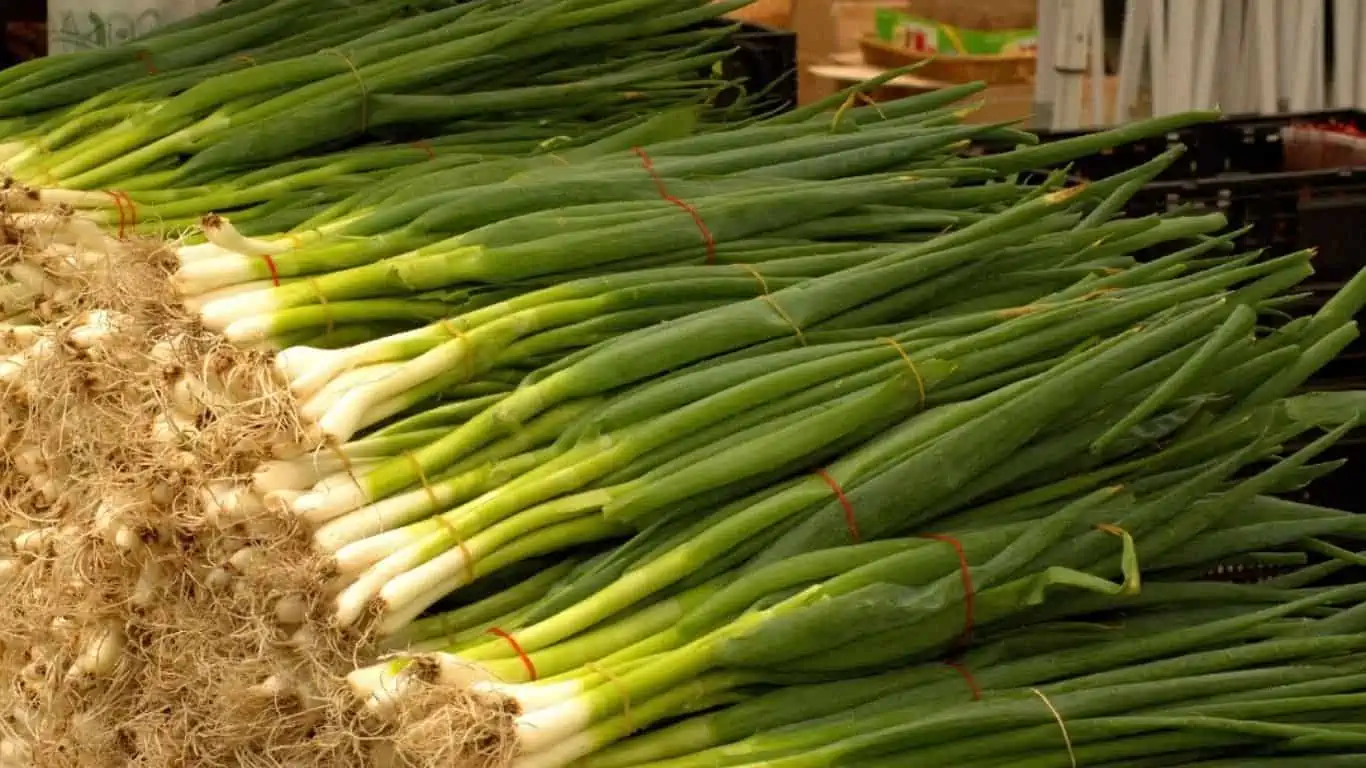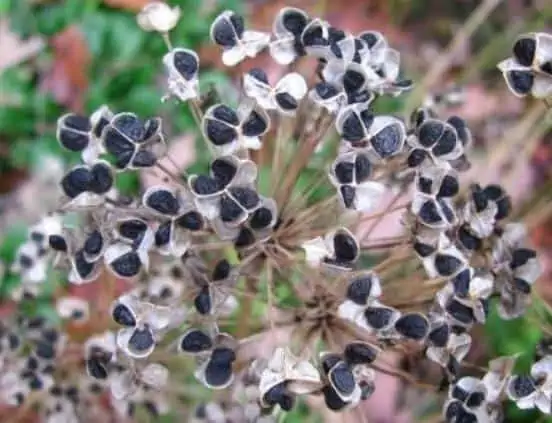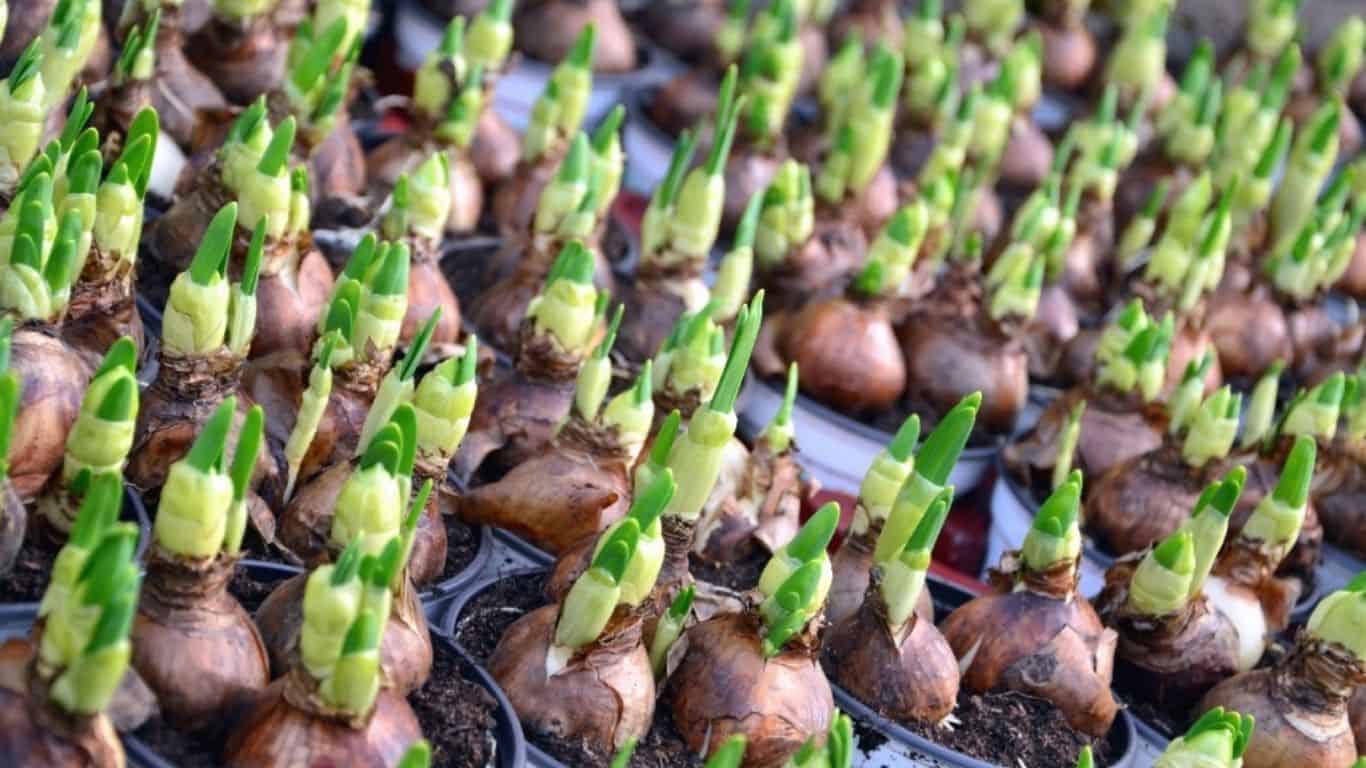Can You Grow Onions in Buckets?- Have you tried growing onions in Containers if not this is the time to start. You can grow Onions in Containers. They require less room for roots and can grow well in any pot bigger than 6 inches. So if you like to have fresh homegrown onions then start container gardening.

Read my previous post: When is the Right Time to Water Anthuriums? 6 Signs of Dehydration
Basic Requirements for Onion Plants
- Plant Type: Annual Herb, Root Vegetable.
- Plant Size: 15-25 inches high on maturity.
- Growth Season: Spring and late Summer.
- Hardiness: Grow in Containers anywhere from USDA hardiness zone 5 through 9.
- Varieties: Both Red and White onions have many varieties available according to climate and location. You should prefer the best for your local conditions.
- Propagation: Onions are grown from seeds. You can directly sow the seeds or grow them from onion sets(Pre-grown baby onion bulbs).
- Sunlight: Part shade to Ful Sunlight for 6 or more hours every day.
- Soil: Soft moist, well-drained slightly acidic soil is good for onions. Plain garden soil will also work if it’s good with drainage.
- Water: Keep the soil slightly moist for best onion growth. Never over water as too much water can cause root rot in onions.
- Temperature: Onion plants prefer moderate temperature. So it’s better to keep them in the range of 60-85 degrees Fahrenheit. They can survive extreme heat more than 35 degrees celsius but it’s not good for plant health.
Can You Grow Onions in 5 Gallon Buckets?
You can easily Grow Onions in 5-gallon buckets. Only make sure it has a sufficient depth of 8 or 10 inches for proper root growth. Make a few holes at the bottom of the bucket for drainage and use healthy soft and organic soil mix. You can use Any commercial potting soil for growing Onions in the container.
Urban Gardeners or anyone living in apartments can benefit from this technique. You can use any bucket or household container of equivalent size to grow onions. It’s easy and needs no extra care.
How to Grow Anthurium in Water?
Things To Know Before Proceeding
There are a few things that you must know before growing onions. As you are preparing for the onion plants, make sure you start with a clean and healthy environment. Onion seedlings are prone to fungal infection, especially in an indoor, moist, and warm environment.
Onion seed requires time and adequate temperature. Sometimes this can become a problem for indoor seed germination. If you are having similar problems then keep the seedling tray near the surfacing window. The sunlight will increase the germination rate.
Onions grown for seeds can become crowded in no time. Therefore you may have to remove a few seedlings to maintain the proper room. You can replant those uprooted onion seedlings and trust me they will perform better than others.

Check out: Is Onion a root, stem, or a fruit?- kitchen garden Facts
What variety of Onions To Grow?
Just like any other vegetable onions also have many varieties. In general, there are only two of them, the red onion and the white onion. Both of which have many variants specially developed for specific growth conditions.
I can name a few of those varieties but you don’t need to find those in your local area. Therefore I would suggest deciding whether you like white or red onion and then visiting your local seed store for the purchase. you can also buy onion seeds from Amazon. Many good and authentic seed sellers are now available online.
One important tip that can help you with vegetable gardening is- ” Always buy fresh seeds. Never grow vegetable seeds older than 2 years, they will not perform optimally”.
Onion Seeds vs Sets, Which is Better?
Seeds are the only way to propagate Onions even for container gardening. Although They don’t perform well if grown directly from seeds. Instead, traditional onion farmers prefer germinating and growing small onion plants in batches. Then they separate and replant the seedlings to the actual growth location. In this way, the onion bulbs grow bigger and yield higher returns.
Therefore you should start onion in containers with seeds. And if you have the time then replant them separately at a 5-6 inch distance once they grow taller than 5 inches. The baby onion seedlings with small bulbs are called onion sets. You can also buy live onion sets to grow from local nurseries.

When To Plant Onion Sets?
You should plant onion sets in containers once they are big enough with a visible bulb. The onion seedlings must have a minimum height of 6 inches from root to the top of their leaves. Onion set plantation can be done anytime after the risk of frost is over in spring. If you are a late-season gardener then do this after mid-summer. Make sure the temperature is suitable for onions and avoid overheating especially during summer days.
Best Time to Show Onion Seeds in Containers
You can also start onions directly from seeds. It is a more effective method as you will get more plants at a low cost. Buying seedlings or onion sets is more costly than growing them from seeds.
Indoor urban gardeners can start onion seed sowing anytime through the year. The temperature inside your house is usually sufficient for seed germination and enough to save the germinated seedlings from cold. Only plan ahead as the total procedure will take 3 or 4 months. Therefore if you want to harvest onions before thanksgiving dinner then sow the seeds from April to early June.
You can grow two separate batches of onions in the container. One for the early summer harvest and another for the fall or holiday season harvest. This is not possible for an outdoor garden.
I would suggest sowing onion seeds 4-6 weeks before last first and preparing the seedlings by that time. You can transplant the onion sets in early spring and they will be ready to harvest by summer. Similarly, start another batch from late March to May for the Holliday season onion harvest.
Only consider optimum temperature and moisture as they are crucial for the growth of onion plants.
Tools Required for Growing onions in Buckets
Container gardening is always a resource-heavy task especially if you are shifting from traditional gardening. It will require more resources than an open garden. You have to be more careful with watering and container sizes. Although it is a recourse-heavy job yet you may need to spend only once for most of your equipment. Later you can reuse all of them for the next batch of plants. If you are new then I would recommend checking the Container gardening kit on Amazon for ease, Although it’s completely optional.
You will need…
- Container: An 8 or 10-inch Container. You can also use a 5-gallon Bucket or Grow bag for Onions. Make sure these containers have some drainage holes in them and they should have at least an 8-inch depth.
- Seed or Sets: You will need onion seeds if you are planning to garden from scratch. Although you can also buy healthy onion sets from local nurseries.
- Potting Soil: Use light soft organic soil for onions. Any commercial potting soil mix is fine for growing onions. You can also use plain garden soil with fine sand and compost to grow onions.
- Fertilizers: Onion plants can Benefit from All-purpose fertilizers. If you want better growth and bulb development in onion then use Phosphorus and potassium-rich fertilizers like NPK 10:20:20. Bone meal fertilizer is also very efficient for healthy onion growth.
For extras…
You may need a drill or a screwdriver for making holes in the Bucket. Sometimes wooden boards or bricks can also help in indoor garden setup instead of buckets. Bricks can also help in maintaining the proper elevation of the container, especially for proper drainage and thermal conductivity.
How to Grow Onions in Buckets?
- Start with a 5-gallon bucket or bigger container. Clean the container with water and sprinkle a little bit of fungicide inside it.
- Make a few holes at the bottom of the bucket using a sharp screwdriver or a drill bit. Commercial grow bags don’t require extra drainage holes so you can skip this step.
- Fill the Container with healthy soft and organic potting soil. Leave at least 2-inch space at the top, especially for water and fertilizers.
- Make 6-8 holes in the soil and maintain a minimum of 3-inch space between them. Keep the holes at least 2-3 inches deep enough to accommodate the onion sets.
- carefully place one healthy onion set in each hole and bury the bulb properly. Gently push it down for settling the soil and tap to release any air pockets.
- Water thoroughly for the first time. Keep watering until it drips out of the drainage holes. Reduce water from every subsequent spell.
- You can add fertilizer like NPK directly to the soil before planting the onion sets. Instead, I would recommend fertilizing the soil every time once in 20 days with watering.
What is 312 Fertilizer and How to use it? Plant Care
General care for Onions in Buckets
- Onion plants can catch fungus easily in containers or buckets. Excess moisture and lack of thermal conductivity of the container results in fungal growth. You should apply contact fungicide in the soil before planting onion sets.
- Keep the soil most and always water when the topsoil starts drying. Never overwater the soil, soggy soil can cause root rot in onion bulbs.
- Deadheading is usually not necessary for onions as they don’t have much foliage. Although it is better to keep the dead leaves away from the onion plant. This can reduce the chance of pest attacks.
- Remove any dead or rotting onion plants from the batch even after plantation. This is essential to prevent any disease spread in the entire onion batch.
- Harvest the onions once the leaves start yellowing after 120-140 days of seed sowing. Sometimes it may take longer for onions to mature although you can harvest onions early if you need.
